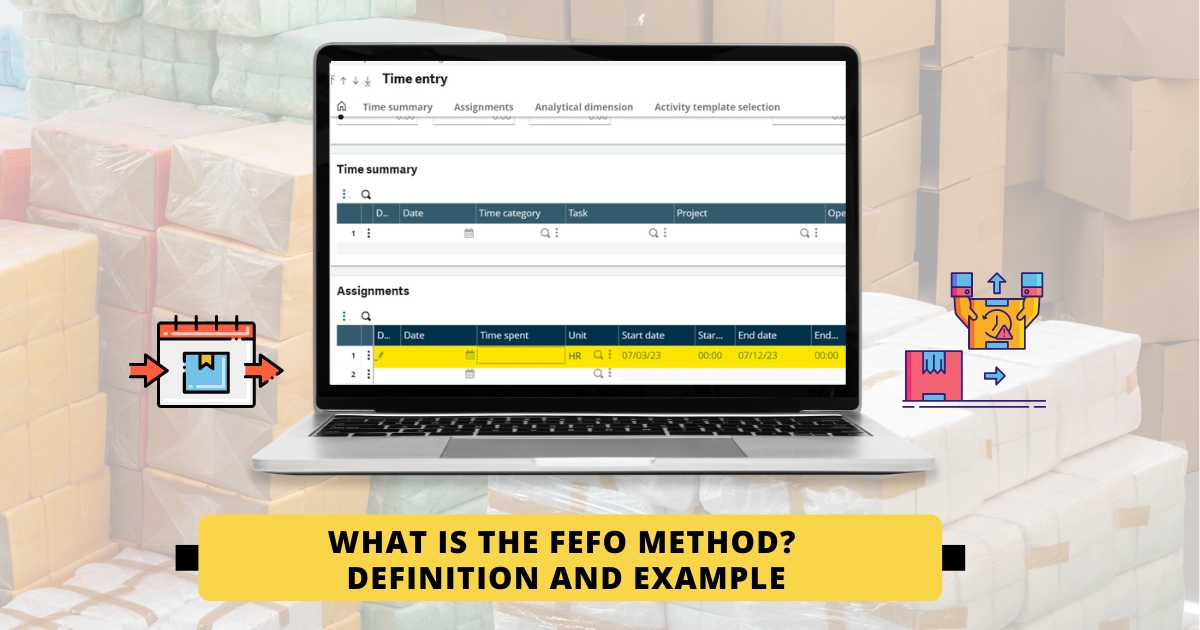FEFO Definition: FEFO stands for First-Expired, First-Out, a method for managing inventory where the items close to the expiry date are given a priority and used before new items. This method ensures efficient inventory consumption, reduces waste and minimizes financial loss due to expired and unsold inventory.
What is FEFO Method?
FEFO method is an inventory management technique in which the product that has the earliest expiration date is allocated for a new customer order. Selling and using near-expiry or items expiring first minimizes the risk of outdated products while ensuring product quality standards.
The FEFO method can be implemented effectively with the help of inventory management software, and is used specifically for tracking perishable goods or those with a limited shelf life, such as food, pharmaceuticals.
For example, if a processed food product uses milk and cheese as raw materials, the old batch of milk and cheese is consumed first during production. Similarly, in a pharma plant making medicines, the Active Pharmaceutical Ingredients (APIs) from the older batch are used before moving on to the fresh batch.
FEFO method is used specifically for perishable goods, such as food, pharmaceuticals, and pharmacy. The FEFO method ensures that the oldest items are sold or used first, which minimizes the usage risk of outdated products and reduces waste.
Also Read : What is the FIFO method in Inventory? Definition and how to use it?
Why is FEFO Method used?
FEFO(First Expired First Out) is a crucial process for the warehouse function in the food and drug industry that prioritizes selling perishable products with the closest expiration first. In this blog post, we will explore the importance of the FEFO system in the food & drug industry, how it differs from the FIFO system, and how can FEFO method of stock movement can be achieved in SAGE X3 system
The FIFO method is very similar to the above method, but instead of using the expiry date as a basis for the priority issue of products, the criteria is the date of entry of the product in the warehouse. Thus, if products have the same expiry date, the first one to be issued would be the first one that entered.
Use of the FEFO method is often unrealistic manually, so digital tools have helped to maintain control over the entire supply chain to facilitate all logistics operations. Irrespective of the management method chosen, it is necessary and recommendable to have software such as SAGE software among others, to control inflows and outflows, locations, batches, expiry dates… for the fully effective management of any technique chosen.
For FEFO method to work the stock must be maintained lot wise so that record of expiry date of each lot is available in system that will help in tracking of such products easily. It is best to use the FEFO method if you sell perishable goods, food and beverage industry, or a pharmacy where offering a product past its expiry date can have serious consequences.
Example of FEFO
We have learned that FEFO is a method used to move the inventory in such a way that the earliest expiring products are sold first. Let us learn deeply about the First Expire, first out FEFO with an example.
- Let us take an example of a Pharma company that uses the FEFO inventory keeping.
- Assume that in January, a lot X of product A with quantity 10000 is manufactured with MFG date 01st January 2023 and Shelf life of 24 months i.e. the stock expiry date will be 31st December 2025.
- Further, in February, a lot Y of same product is manufactured with quantity 10000 with mfg date 01st Feb 2023 and expiry date as 31st January 2026.
- Hence, when the delivery of this product in March 2023 for quantity 11000 is to be done This method ensures that the lot X is selected first and afterwards the lot Y will be selected for delivery ensuring that first perishable lot is selected automatically.
Steps to apply FEFO method in SAGE X3
Step 1: – FEFO method can be easily achieved through Stock Setup in SAGE X3, you just need to change the allocation and issue rules in setup, to FEFO
Step 2: In Product master select the stock management as “Managed”, Lot management as “Mandatory lot” and in Expiration control management, select “Mandatory Entry”
Step 3 :During purchase receipt entry, select the product and enter its lot with expiry date and MFG date, and during delivery, system will auto select the first expiring lot automatically
What Are The Advantages Of FEFO Method?
The following are the various benefits of implementing the FEFO method in your organization.
- Stock levels are carefully managed by ensuring older stock items are sold or used first. As a result, businesses don’t have to get rid of old stock by selling it at low profit margins.
- Keep customers happy by delivering products that meet the desired quality standards, boosting customer loyalty and maintaining brand reputation.
- Reduce waste by making sure that items are sold or used before they expire or get bad due to spoilage, cutting down the risk of dead inventory.
Comply with regulations by only selling products that are safe and fit for use. For example, using expired ingredients due to a lack of proper monitoring in the pharma industry carries the risk of heavy penalties and legal problems.
FEFO Method FAQs
1. What Is The Difference Between FEFO, LIFO, And FIFO?
The full form of FEFO is First-Expired, First-Out, meaning the inventory expiring first is sold or used before newer stock. Similar to FEFO, FIFO stands for First-In, First-Out, i.e. the items that arrived first in the warehouse are consumed before the newer items. In contrast to FEFO and FIFO, LIFO means Last-In, First Out. LIFO is an inventory costing method where the cost of the latest stock items in the warehouse is used for calculating the cost of goods sold.
2. Where Is FEFO Used?
FEFO is used in industries with perishable goods or where products have a limited shelf life, such as food, chemical and pharmaceutical manufacturing businesses.
3. What Is The FEFO Principle?
The FIFO principle states that the inventory items that are going to expire first have to be removed first from the warehouse.







